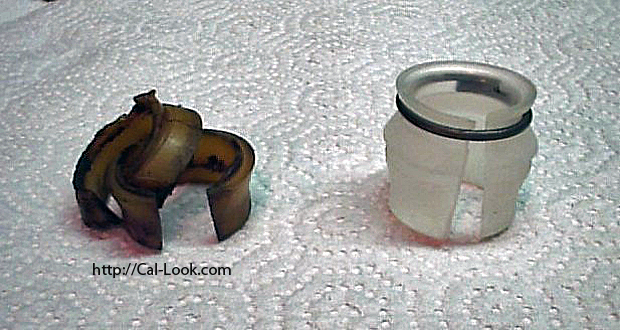
02 Jun Volkswagen Beetle Shift Rod Bushing Replacement
After installing the Berg 5 transmission, I noticed that the gear location was difficult. When downshifting from 3rd into 2nd, it would sometimes try to engage reverse, causing a rather loud grinding noise (not good thing). I spoke to Gary Berg, who built the tranny, and he told me that the shift rod bushing was probably the cause. It must be in perfect condition and properly lubricated for precise shifting. He also said that the support bracket could be damaged and might need to be replaced.
I decided to tackle the problem right away and not risk the chance of damaging the transmission. I purchased the following parts (VW part numbers): 111-701-225B shift guide, 111-701-259A bushing, 111-701-263 clip for bushing and 311-798-211 shift rod coupler.
The shift rod needs to be removed in order to replace the bushing. It’s moved toward the front until the end clears the bushing support. There is an inspection plate on the frame head that must be removed. It’s held on with two 10 mm bolts. You then remove the two 13 mm bolts that hold down the shifter. At this point I was able to reach in and check the play in the shift rod. To my surprise there was too much play; in fact, after a closer inspection, I found that the bushing wasn’t worn out, but was missing and broken in three pieces.
I next removed the rear seat bottom to get access to the shift rod coupler. You will need a Philips screwdriver to remove the cover plate. Use an 8 mm wrench and needle nose pliers to remove the lag bolt that holds the shift rod to the coupler. Use an 8 mm open-end wrench to remove the square setscrew that holds the coupler to the transmission.
Now comes the fun part; you need to push the shift rod towards the front until it clears the bushing support. I used long needle nose pliers that are bent 45 degrees to gently move it. When you get about 3” from the back end of the rod, the front end has to be passed through the inspection hole in the frame head. You need to go to the front and reach in and lift it through. It’s really tight and not that easy. I use a bent wire hanger to help grab it. I also use another wire hanger to support the back end of the rod once it comes off the bushing support. It will otherwise drop into the tunnel.
If your old bushing is there, you need to reach in and remove it. The support is about 1.5” past the shifter opening. It’s really tight so take your time. Take a few seconds to inspect the bushing support. If it is damaged, then it needs to be replaced (a major pain and not covered here). You are now ready to install the new bushing. Make sure the clip is in place and carefully push it into the support. The bushing has a grove and makes a positive snap when it’s in place. Check the fit to make sure the support isn’t damaged. There’s a cut in the bushing, it should be rotated to face the driver’s side. Apply some grease to the bushing and push the shift rod back into it. Use the needle nose pliers to carefully slide the rod back. Apply some grease, with a small acid brush, every few inches. When the rod is almost in place you can move to the coupler opening in the back and pull it the last few inches. Now simply install the new coupler. Make sure the square setscrew is correctly in place and use a safety wire to ensure that it does not come loose. Finally, reinstall the shifter and the inspection plate in the frame head and you’re done!
You are now ready for many years’ of smooth shifting; no more searching for gears. This is one of those things you do every 20 years. Hopefully, you’ll have the car 20 years from now to do it again.

